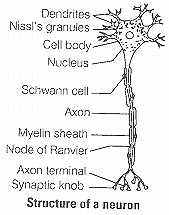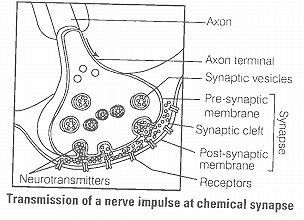29. Explain the process of the transport and release of a neurotransmitter with the help of a labelled diagram showing a complete neuron, axon terminal and synapse.

Transport and release of a neurotransmitter occurs within a synapse At a chemical synapse the membranes of the pre - and post - synaptic neurons are separated by a fluid-filled space called synaptic cleft. Chemicals called neurotransmitters are involved in the transmission of impulses at these synapses. The axon terminals contain vesicles filled with these neurotransmitters.
When an impulse (action potential) arrives at the axon terminal, it stimulates the movement of the synaptic vesicles towards the membrane, where they fuse with the plasma membrane and release their neurotransmitters in the synaptic cleft.
The released neurotransmitters bind to their specific receptors, present on the post-synaptic membrane. This binding opens ion channels allowing the entry of ions which can generate a new action potential in the post-synaptic neuron.


© 2025 GoodEd Technologies Pvt. Ltd.